cut flowers
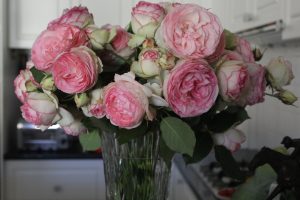

Do you always have cut flowers in the house? My mother and both Grandmothers, all three keen gardeners, always had fresh flowers in the house. My mother still does and so do I, so I’m always interested in ways to keep them fresh.
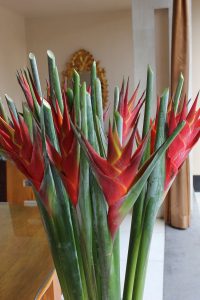

Probably the most important thing is getting flowers into clean, cool water as soon as possible after cutting. Before you put them in the vase, trim the end of each stem. Make sure your vase is clean as the bacteria in a dirty vase will hasten the decay of the flowers. Strip the leaves from the stem so none are submerged in the the water.
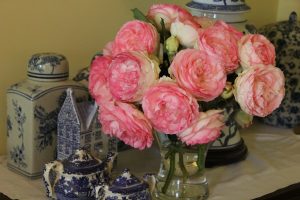

Little sachets of preservative work well. (I buy boxes of them from EBay but am trying to find a way of buying a jar full of the preservative or a big paper sack.) Apparently, half a teaspoon of citric acid per litre of water works well, too. I will try this soon. Don’t add sugar, it feeds bacteria. Ethylene, a gas produced by ripening fruit, will affect your flowers, too. Keep them apart. Try to keep vases of flowers out of direct sunlight and change the water regularly. Roses last longer than many other flowers.
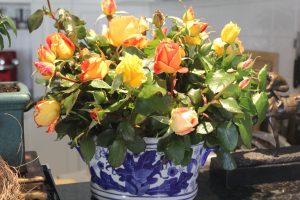

If you’re buying flowers, ask where they’ve come from as many flowers for sale in Australia are flown here from overseas. They have probably been dipped in glyphosate or been fumigated. The Australian climate means not enough flowers to can be produced here to meet the market demand. If you’re picking them yourself, go out early in the morning or late afternoon and place them in a bucket of water until you’re ready to arrange them. I often put them in the sink as there’s plenty of work space.*
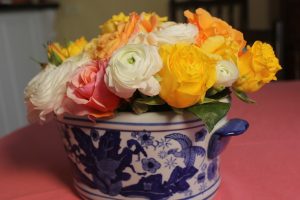

Traditionally, stems were cut at angle (still a good idea) then singed on a hot stove. This is not necessary to prolong the longevity of your blooms.
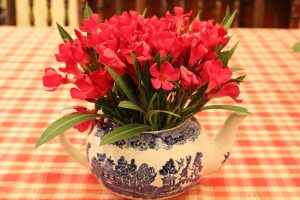

I use vases I have inherited, been gifted or, in the case of very long stemmed roses, a vase I found at an op shop (thrift store) It is just the right size! Another favourite is an old, lidless, Willow Pattern teapot. I remember my Grandmother using a metal hedgehog type of fitting, a ‘frog’ to support stems in arrangements but I resort to scrunched up chicken wire, a crisscrossed pattern of rubber bands or sometimes sticky tape arranged to make a grid.
* I was motivated to write about cut flowers after reading Helen Young’s column “GARDENS Cut Above’ in the Weekend Australian magazine, March 4-5th, 2023
international women’s day
In the 70’s as young women in an all girls school we were encouraged to believe we could do anything and go anywhere. Germaine Greer’s The Female Eunuch had been widely read and we though change was in the air! We did have more options when we left school as we were well educated and exposed to an array of possibilities rather than just nursing, teaching or secretarial work. (Male teachers were paid more than females at this time.) Sadly it seems the barriers preventing women worldwide from participating in all levels of society and employment are still in place in every country.
It was very sobering to read the goals and data behind International Women’s Day. The three obstacles preventing women worldwide from participating fully in the economy, as defined by the World Bank are:
1. Nearly one in three women globally have experienced violence, with intimate violence impacting women in every country.
2. During the last three decades the gap in opportunities between male and female participants in the economy has not narrowed.
3. More than one in five women around the world have been child brides, limiting their life long participation in paid work.
Women are still frequently paid less than men for the same work, are passed over for promotion and retire with significantly less superannuation in Australia. When will it ever change?
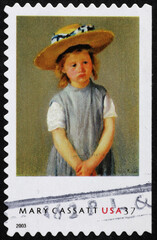

Adobe Series of USA stamps featuring Mary Cassatt’s images
Women With A Fan Rawpexel
To commemorate International Women’s Day we went to the cinema to see Mary Cassatt:Painting The Modern Woman. American by birth, Cassatt (1844-1926) decided at a young age she was going to be a painter. Unable to join the more important schools of art in America which didn’t accept females student she headed to Paris. Well traveled as a young girl she identified the opportunities to develop as an artist in Europe. She studied at a minor school of art in Paris before joining the Impressionists.
Mother’s Kiss
Her style of painting was also influenced by her European travels. Financially secure and very determined, she was initially trained in the style of the classics but soon joined the radical group, the Impressionists. She was particularly friendly with Edgar Degas who was also fascinated by women going about their daily business. Cassatt’s artworks, including pastels, prints and paintings, featured light colours and loose brushwork. She painted women involved in everyday occupations. She wanted to present the woman’s perspective.


The Child’s Bath
Leaving France at the outbreak of the Franco-Prussian war she returned to America. She is best known for her paintings and prints of the social and private lives of women. She never married or seemed to have any romantic attachments but is famous for her paintings of women and children. Her style of painting continued to evolve for the rest of her life.
There was a funny account in our local paper, written by a woman, describing how she was left to ‘mind’ the office while all the men went out to celebrate International Women’s Day. They didn’t return to work that day.
I’m not laughing.
